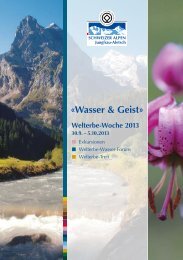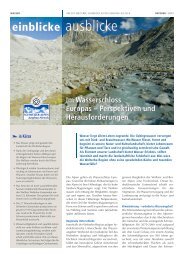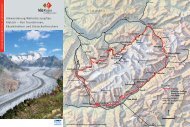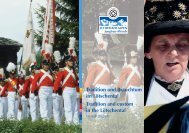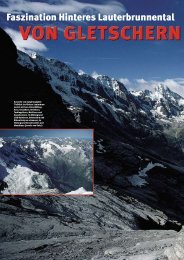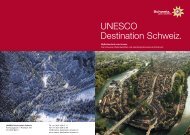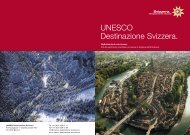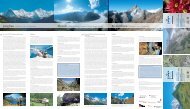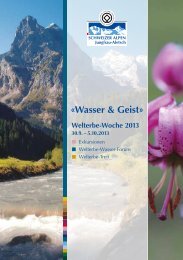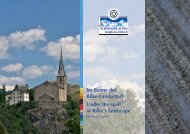Zwischen Vergänglichkeit und Ewigkeit – Kultur im Berggebiet ...
Zwischen Vergänglichkeit und Ewigkeit – Kultur im Berggebiet ...
Zwischen Vergänglichkeit und Ewigkeit – Kultur im Berggebiet ...
Sie wollen auch ein ePaper? Erhöhen Sie die Reichweite Ihrer Titel.
YUMPU macht aus Druck-PDFs automatisch weboptimierte ePaper, die Google liebt.
<strong>Zwischen</strong> <strong>Vergänglichkeit</strong><br />
<strong>und</strong> <strong>Ewigkeit</strong> <strong>–</strong><br />
<strong>Kultur</strong> <strong>im</strong> <strong>Berggebiet</strong><br />
Between Transience and<br />
Eternity <strong>–</strong> Culture in a<br />
Mountain Region<br />
Deutsch | English
2<br />
1 <strong>–</strong> 3<br />
Einzigartige Verbindung von Natur- <strong>und</strong> <strong>Kultur</strong>landschaft:<br />
Alpweiden auf Männlichen mit der Eigernordwand<br />
(1), Aletschbord auf Belalp mit dem Aletschgletscher<br />
(2), Hochebene bei Mürren (3)<br />
Striking juxtaposition of natural and manmade landscapes:<br />
alpine pastures on the Männlichen against the<br />
North Face of the Eiger (1), Aletschbord at Belalp and<br />
the Aletsch glacier (2), plateau at Mürren (3)<br />
1<br />
Ein <strong>Berggebiet</strong> als vielschichtiger <strong>Kultur</strong>raum<br />
Natur <strong>und</strong> <strong>Kultur</strong> gelten landläufig als gegensätzliche Begriffe: Hier<br />
eine festgefügte, ursprünglich vorhandene Welt <strong>–</strong> dort ein von Menschenhand<br />
bewusst geordneter, auf begrenzte Zeit angelegter Kosmos. Doch<br />
die beiden Sphären sind vielfach miteinander verflochten. Beispielsweise<br />
gestalten Menschen das Gesicht der Landschaft mittels Landwirtschaft<br />
(Agri-<strong>Kultur</strong>); umgekehrt hat die natürliche Umgebung prägende Auswirkungen<br />
auf kulturelle Ausdrucksformen.<br />
Das UNESCO Welterbe Schweizer Alpen Jungfrau-Aletsch ist von einer<br />
rauhen Topografie gekennzeichnet: Einsame Höhen, schroffe Felswände,<br />
Eis <strong>und</strong> Schnee bilden einen Rahmen, der zwar ästhetisch sehr reizvoll<br />
ist, doch seit jeher eine erhebliche Herausforderung für die Menschen<br />
bedeutet. In charakteristischer Weise hat sich dies etwa in der Sagenwelt,<br />
<strong>im</strong> Brauchtum oder in kulinarischen Spezialitäten der Region niedergeschlagen.<br />
Bemerkenswert ist zudem, dass das Welterbe-Gebiet mehrfach<br />
Schauplatz für die Entstehung herausragender Kunstwerke war.<br />
Indessen sollte man sich hüten, die Region als kompakten <strong>und</strong> homogenen<br />
<strong>Kultur</strong>raum aufzufassen: Besonders zwischen dem (nördlichen) Berner<br />
Teil <strong>und</strong> dem (südlichen) Walliser Teil bestehen in kultureller Hinsicht<br />
mitunter markante Unterschiede.
A mountain region with a complex culture<br />
Nature and culture are commonly held to be opposing concepts:<br />
the one is a world unchanged and unchanging, and the other a space intentionally<br />
ordered by human hand and of l<strong>im</strong>ited duration. And yet the<br />
two areas intertwine. Human beings shape the face of the countryside,<br />
for example: “agri-culture” is the culture of the fields, while at the same<br />
t<strong>im</strong>e the natural surro<strong>und</strong>ings strongly influence the ways in which culture<br />
is expressed.<br />
The dominant feature of the UNESCO Swiss Alps Jungfrau-Aletsch World<br />
Heritage Region is the harsh topography: its lonely peaks, rugged cliffs,<br />
ice and snow create a setting that is aesthetically very magnificent, to<br />
be sure, but one which has always posed a considerable challenge to<br />
human beings. This is typically reflected in the legends, customs and<br />
culinary specialities of the region. It is remarkable, too, how often the<br />
World Heritage Region has been the backdrop for the creation of some<br />
outstanding works of art.<br />
At the same t<strong>im</strong>e we should be careful not to see the region as a compact<br />
and homogenous cultural space: as far as culture is concerned, there are<br />
some striking differences, especially between the (northern) Bernese part<br />
and the (southern) Valais part.<br />
2<br />
3<br />
3
4<br />
Kraftvoller Dialekt<br />
mit unverwechselbarem Charakter<br />
Die Sprache zählt zu den ältesten <strong>im</strong>materiellen Erbgütern der<br />
Menschheit. Im Gebiet des Welterbes Jungfrau-Aletsch weist die M<strong>und</strong>art<br />
einige besonders kraftvolle Eigenheiten auf. Hier werden höchstalemannische<br />
Dialekte gesprochen, die stark an die Form des Deutschen von vor<br />
1000 Jahren erinnern. Das zeigt sich beispielsweise an den oft ausgesprochen<br />
klangvollen Endsilben, die <strong>im</strong> Wallis verwendet werden: «Der Vatter<br />
ischt aaltä»; «D Müetter ischt aalti»; «Ds Hüs ischt grossus».<br />
Kennzeichnend für das «Wallissertiitsch» ist aber auch die Aussprache<br />
mancher Laute. Während es anderswo in der Deutschschweiz etwa «guet»,<br />
«Puur» oder «Füür» heisst, sagt man <strong>im</strong> Wallis «güet», «Püür» <strong>und</strong> «Fiir». Dieser<br />
Unterschied wird zusätzlich durch Melodieschwankungen akzen tuiert,<br />
die deutlich stärker sind als in anderen Dialekten der Deutschschweiz <strong>–</strong><br />
Walliserdeutsch werde «gesungen», heisst es oft.<br />
Manche dieser Eigenheiten finden sich aber auch in den Dialekten des Berner<br />
Oberlands <strong>–</strong> bis hin zum Wortschatz. Das «Ggufer» (Gestein) <strong>und</strong> die<br />
«Griiffle» (Preiselbeeren) beispielsweise sind sowohl <strong>im</strong> Lauterbrunnental<br />
als auch <strong>im</strong> Oberwallis bekannt.
1<br />
A vigorous dialect<br />
with an unmistakable character<br />
Language is one of the oldest intangible heritages of mankind. In<br />
the Jungfrau-Aletsch World Heritage Region the dialect displays some<br />
particularly striking local characteristics. The dialects spoken here are<br />
what is known as Highest Alemannic, remarkably close to the German<br />
spoken 1000 years ago. One example is the adjectival endings that are<br />
often pronounced in the Valais: “Der Vatter ischt aaltä”; “D Müetter ischt<br />
aalti”; “Ds Hüs ischt grossus”, where standard German has s<strong>im</strong>ply “alt”<br />
or “gross”.<br />
“Wallissertitsch” <strong>–</strong> Valais German <strong>–</strong> is also <strong>im</strong>mediately recognisable by<br />
some of its vowel so<strong>und</strong>s. Elsewhere in German-speaking Switzerland<br />
people say “guet”, “Puur” or “Füür”, but in Valais it's “güet”, “Püür” and<br />
“Fiir”. This difference is accentuated by the intonation, which is more lilting<br />
than other Swiss German dialects: Valais German so<strong>und</strong>s to outsiders<br />
as if it's being sung.<br />
But some of its characteristics are also fo<strong>und</strong> in dialects of the Bernese<br />
Oberland <strong>–</strong> including the vocabulary. For example the words “Ggufer”<br />
(standard German Gestein, or stone) and “Griiffle” (Preiselbeeren,<br />
or cranberries) are known in the Lauterbrunnen valley as well as in the<br />
Upper Valais.<br />
1<br />
Walliser Sagen,<br />
Tscheinen <strong>und</strong> Ruppen<br />
Valais tale, Tscheinen<br />
and Ruppen<br />
5
6<br />
Sagenwelt: Ein kostbares Erbe aus alter Zeit<br />
Als unbegreiflich <strong>und</strong> bedrohlich empfanden<br />
die Menschen früher die Natur. Das galt in<br />
besonderem Masse für das Gebirge. Gelände <strong>und</strong><br />
Witterung bargen Gefahren, die urplötzlich zum<br />
Verhängnis werden konnten. Das Unfassbare liess<br />
sich einzig dadurch bewältigen, dass darüber gesprochen<br />
wurde. Unerklärliche Vorgänge <strong>und</strong><br />
merkwürdige Begebenheiten fanden auf diese<br />
Weise Eingang in Geschichten, die durch mündliche<br />
Überlieferung von Generation zu Generation<br />
weitergegeben wurden.<br />
Solche Sagen bilden einen wertvollen Bestandteil<br />
des <strong>im</strong>materiellen Erbes in der Welterbe-Region.<br />
Die klassische Erzählsituation <strong>–</strong> abends an der<br />
Feuerstelle in der Alphütte <strong>–</strong> ist zwar längst Geschichte.<br />
Doch der F<strong>und</strong>us an Sagen wird noch <strong>im</strong>mer<br />
aktiv gepflegt, besonders <strong>im</strong> Oberwallis: Dort<br />
besteht eine lebendige Szene von einem Dutzend<br />
freischaffender Sagenerzählern, welche die traditionellen<br />
Sagen am Leben erhalten. An ihren Erzähl-<br />
abenden berichten sie von den armen Seelen,<br />
die in der kalten Hölle des Aletschgletschers<br />
Busse üben, oder vom Rollibock, der Murgänge<br />
<strong>und</strong> Überschwemmungen auslöst, wenn er von<br />
Menschen unvorsichtigerweise be<strong>im</strong> Namen<br />
genannt wird.<br />
Ähnlichen Themenkreisen begegnet man auch<br />
in der Sagenwelt des Berner Oberlands: Die<br />
Grindelwalder Sage vom Challi-Groosi etwa<br />
erklärt die Ursache von Föhnstürmen mit dem<br />
Treiben eines alten Mannes, der hinter dem Eiger<br />
haust. Andere Geschichten berichten von<br />
Geistern, Drachen, Riesen oder Zwergen. Ein<br />
Motiv, das vielerorts auftaucht, handelt vom<br />
Untergang eines goldenen Zeitalters. Beispielhaft<br />
zeigt es sich in der Blüemlisalp-Sage. Darin<br />
geht eine einst blühende Alp infolge Frevels unter<br />
Eis <strong>und</strong> Fels zugr<strong>und</strong>e.
1<br />
2<br />
1 Sagenerzähler Leo Jossen<br />
2<br />
Sage: «Schoch d'alt Schmidja spinnt noch»<br />
Story teller Leo Jossen<br />
Legend: “We're cold, but old Schmidja is still spinning!”<br />
Legends: a precious heritage from long ago<br />
People used to see the natural world as<br />
something dangerous that they could never fully<br />
<strong>und</strong>erstand. That was especially true of the<br />
mountains. The bare landscape and the unpredictable<br />
weather hid dangers which could suddenly<br />
spell doom. The only way to cope with<br />
what could not be <strong>und</strong>erstood was to speak<br />
about it. This is how inexplicable incidents and<br />
strange events fo<strong>und</strong> their way into stories that<br />
were passed on orally from one generation to<br />
the next.<br />
Such legends are in <strong>im</strong>portant part of the intangible<br />
heritage of the World Heritage Region.<br />
It's true that the classic story-telling situation <strong>–</strong><br />
gathered of an evening ro<strong>und</strong> the fireplace of<br />
the alpine hut <strong>–</strong> is long gone. But the wealth<br />
of stories is still actively preserved, especially<br />
in the Upper Valais. There is a vigorous scene<br />
there with a dozen freelance story-tellers who<br />
keep the traditional legends alive. At their story-<br />
telling evenings they speak of the poor souls doing<br />
penance in the cold hell of the Aletsch glacier, and<br />
of the Rollibock, which unleashes mud slides and<br />
floods if people carelessly mention his name.<br />
S<strong>im</strong>ilar kinds of subjects are fo<strong>und</strong> in the legends<br />
of the Bernese Oberland: the Grindelwald legend<br />
of the Challi-Groosi, for example, explains the<br />
föhn windstorms as the result of the activities of an<br />
old man dwelling behind the Eiger. Other stories<br />
tell of spirits, dragons, giants and dwarves. One<br />
motif that crops up in many places is to do with<br />
the end of a golden age. A good example is the legend<br />
of the Blüemlisalp, where a once flour ishing<br />
meadow was destroyed beneath ice and rock as a<br />
result of sinful behaviour.<br />
7
8<br />
1<br />
Das Toggeli, eine alte<br />
Sagenfigur aus dem Lauterbrunnental,<br />
sorgt für<br />
nächtliche Atemnot.<br />
The Toggelli, an mythical<br />
figure from the<br />
Lauterbrunnen valley,<br />
stops sleepers breathing<br />
in the night.<br />
Ein seltsamer Schrei<br />
Am Giebelsteinhorn oberhalb Wengen, wo vor<br />
Jahren ein gewaltiger Bergsturz zu Tal gefahren<br />
war, hütete ein Geisshirt seine Herde. Es war<br />
totenstill da oben in der Einsamkeit.<br />
Da zerriss grausam jäh ein geller Aufschrei die<br />
Bergesstille. Jeder Block <strong>und</strong> jede Felskante in<br />
weitem Umkreis gaben den grässlichen Schrei<br />
zurück. Als ob der Teufel auf ihrem Rücken reite,<br />
flohen die Ziegen in alle H<strong>im</strong>melsrichtungen<br />
auseinander. Der Geisser musste einen Tag lang<br />
in allen Falten der Männlichenkette herumklettern,<br />
hojen <strong>und</strong> hopen (= rufen), bis er sie<br />
wieder beisammen hatte. Nicht um alles in der<br />
Welt hätte der Geisshirt sagen können, wer den<br />
Schrei ausgestossen hätte.<br />
War es eine arme Seele unter den Bergsturzblöcken,<br />
die ihrem jahrh<strong>und</strong>ertelang verhaltenen<br />
Weh in einem einzigen Aufschrei Luft gemacht<br />
hatte?<br />
Aus der Sagensammlung «Ein Kratten voll Lauterbrunner<br />
Sagen» von Hans Michel<br />
A strange cry<br />
One day a goatherd was guarding his flock<br />
on the Giebelsteinhorn above Wengen, where<br />
many years ago there was a huge rockslide<br />
which came right down into the valley. It was<br />
deathly still up in that lonely spot.<br />
Suddenly a terrible scream shattered the silence<br />
of the mountains. Every rock and every cliff all<br />
aro<strong>und</strong> re-echoed the dreadful cry. The goats fled<br />
in every direction, as if the devil was riding on<br />
their backs. The goatherd had to spend a whole<br />
day clambering into every nook and cranny in<br />
the Männlichen chain, calling and calling, before<br />
he could get them all back together again.<br />
He could not have said for love or money what<br />
it was that had uttered that scream.<br />
Was it a poor soul buried <strong>und</strong>er one of the rocks<br />
of the landslide, which in a single cry had given<br />
voice to all the pain it had been bottling up for<br />
h<strong>und</strong>reds of years?<br />
From the collection “Ein Kratten voll Lauterbrunner Sagen”<br />
by Hans Michel
1<br />
9
10<br />
Mit Glockenklang <strong>und</strong> Maskentreiben<br />
durch den Winter<br />
Für unsere Vorfahren stellte der Winter die härteste Zeit <strong>im</strong> Jahreslauf<br />
dar, brachte er doch Kälte, Schnee <strong>und</strong> lange Nächte. Neben körperlichen<br />
Entbehrungen litten die Menschen unter nagenden Ängsten vor endloser<br />
Finsternis <strong>und</strong> bösen Geistern. Doch zumindest gegen die Dämonen, so<br />
glaubte man, konnte etwas unternommen werden: Mit Lärm <strong>und</strong> schrecklicher<br />
Verkleidung liessen sie sich vertreiben.<br />
Dieser Gedanke bildet den Kern einer breiten<br />
Vielfalt an winterlichem Brauchtum in der Welterbe-Region.<br />
Welchen Nöten die Bergbevöl-<br />
kerung früher unterworfen war, zeigt sich<br />
noch heute in einem Kandersteger Brauch.<br />
Am Weihnachtstag <strong>und</strong> an Neujahr<br />
ziehen die Pelzmartiga <strong>–</strong> in Fell gehüllte,<br />
maskierte <strong>und</strong> mit Schellen<br />
bewehrte Gestalten <strong>–</strong> durch das Dorf.<br />
Die unhe<strong>im</strong>lichen Figuren geben<br />
menschlichen Ängsten <strong>und</strong> Erlebnissen<br />
früherer Zeiten ein Gesicht:<br />
Der Chindlifrässer erinnert an die<br />
einst hohe Kindersterblichkeit, <strong>und</strong><br />
das Huttefroueli trägt einen <strong>im</strong> Krieg<br />
verletzten Soldaten <strong>im</strong> Tragkorb.<br />
1
1<br />
2<br />
Tschägättä aus dem Lötschental<br />
Tschägättä from the Lötschental<br />
Pelzmartiga ziehen durch das Dorf Kandersteg.<br />
Pelzmartiga on the streets of the village of Kandersteg.<br />
2<br />
Clanging bells and masked<br />
processions in the wintert<strong>im</strong>e<br />
For our ancestors winter was the most difficult<br />
t<strong>im</strong>e of year. It brought cold, snow and long<br />
nights. In addition to the physical hardships, people<br />
suffered from the gnawing fear of eternal darkness<br />
and evil spirits. But something could at least<br />
be done against the demons, people believed: they<br />
could be driven away with noise and frightening<br />
costumes.<br />
This idea lies at the heart of a broad range of winter<br />
customs in the World Heritage Region. The hardships<br />
to which the people living in the mountains<br />
were once subject are still evident in a custom that<br />
takes place in Kandersteg. On Christmas Day and at<br />
New Year the Pelzmartiga run through the village <strong>–</strong><br />
masked figures wrapped in an<strong>im</strong>al skins, and with<br />
bells attached. The sinister figures give a face to<br />
people's once familiar fears and experiences: the<br />
Chindlifrässer, or “child eater”, is a reminder of<br />
high child mortality rates, while the Huttefroueli <strong>–</strong><br />
“basket woman” <strong>–</strong> carries a wo<strong>und</strong>ed soldier in the<br />
basket on her back.<br />
11
12<br />
Im Haslital sind vom Stephanstag an jede<br />
Nacht Treichler <strong>und</strong> Trommler in den Dörfern unterwegs,<br />
spielen st<strong>und</strong>enlang den geradezu hypnotisch<br />
gleichförmigen Trychelmarsch <strong>und</strong> ziehen<br />
damit unzählige Zuschauer in den Bann. Höhepunkt<br />
ist der Ubersitz, der letzte Werktag des Jahres,<br />
wenn sich alle Trommler <strong>und</strong> Treichler in Meiringen<br />
einfinden.<br />
Wildes Treiben herrscht jeweils <strong>im</strong> Februar <strong>im</strong><br />
Lötschental, wenn während der Fasnachtszeit die<br />
Tschägättä unterwegs sind. Dabei handelt es sich<br />
um furchterregende Figuren, die mit Schaf- oder<br />
1<br />
Ziegenpelz behängt sind <strong>und</strong> riesige, aus Arvenholz geschnitzte Masken<br />
tragen. Allein oder in Gruppen ziehen sie durch das Tal <strong>und</strong> flössen besonders<br />
jungen Frauen <strong>und</strong> Kindern Respekt ein. Wer ihnen nicht rechtzeitig<br />
zu entwischen vermag, wird mehr oder weniger sanft umarmt <strong>und</strong><br />
mit Schnee eingerieben.<br />
Wesentlich beschaulicher ist das Niklaustrycheln in Fieschertal <strong>und</strong> Fiesch.<br />
Am 5. Dezember marschieren weiss gekleidete Schüler mit Kuhglocken<br />
durch das Dorf. Angeführt werden sie von einem Fähnrich mit der Gemeindefahne,<br />
<strong>und</strong> einem jungen St. Nikolaus mit Bart <strong>und</strong> Hut. Begleitet<br />
werden sie von einem nicht minder jugendlichen Hauptmann, der mit<br />
einem uralten Säbel den Takt angibt. Von den Dorfbewohnern erhält der<br />
Trupp Mandarinen, Nüsse, Schokolade oder auch Geld geschenkt.<br />
2
3 4<br />
In the Haslital drummers and “treichler” <strong>–</strong> men rhythmically banging<br />
cow bells <strong>–</strong> parade through the village streets each night, starting on<br />
December 26. For hours on end they play the hypnotically monotonous<br />
treichler march, drawing crowds of spectators who fall <strong>und</strong>er their spell.<br />
The high point is the “Ubersitz”, on the last working day of the year,<br />
when all the drummers and treichlers come together in Meiringen.<br />
There are wild goings on in the Lötschental every February, when the<br />
Tschägättä are out and about during carnival t<strong>im</strong>e. These are terrifying<br />
figures draped in sheep or goat skins, and wearing huge masks carved out<br />
of arolla pine. Alone or in groups they make their way through the valley,<br />
int<strong>im</strong>idating young women and children in particular. Anyone who<br />
doesn't manage to get out of their way quickly enough will be hugged<br />
1<br />
2<br />
3<br />
4<br />
Treichler am Ubersitz in Meiringen<br />
“Treichler” at the Ubersitz in Meiringen<br />
Maskierte Trommler am Ubersitz in Meiringen<br />
Masked drummers at the Ubersitz in Meiringen<br />
Tschägättä <strong>im</strong> Lötschental<br />
Tschägättä in the Lötschental<br />
Nikolaustrychler in Fiesch<br />
“Niklaustrycheln” in Fiesch<br />
more or less gently and rubbed with snow.<br />
The “Niklaustrycheln” in Fieschertal and Fiesch is<br />
rather more sedate. On 5 December schoolchildren<br />
dressed in white and carrying cow bells<br />
march through the village. At their head is an ensign<br />
carrying the village flag, a young St Nicolas<br />
with beard and hat. They are accompanied by a no<br />
less youthful captain, who uses an ancient sword<br />
to beat out the rhythm. The troop are given mandarins,<br />
nuts, chocolate and even money by the<br />
villagers.<br />
13
14<br />
1 <strong>–</strong> 2<br />
1<br />
Holzmasken aus dem Lötschental<br />
Wooden masks from the Lötschental<br />
Kunsthandwerk des <strong>Berggebiet</strong>s<br />
für die weite Welt<br />
Holz <strong>und</strong> Stein <strong>–</strong> diese Materialien stehen <strong>im</strong> Welterbe-Gebiet<br />
praktisch in unbegrenzter Menge zur Verfügung. Seit jeher werden sie<br />
für den Bau von Häusern <strong>und</strong> Ställen genutzt. Im Laufe der Zeit kamen<br />
sie aber auch für kunsthandwerkliche Anwendungen zum Einsatz. Bekanntestes<br />
Beispiel dafür ist die Holzschnitzerei <strong>im</strong> Berner Oberland, die<br />
ihren Ursprung Anfang des 19. Jahrh<strong>und</strong>erts in Brienz hatte (wo noch<br />
heute ihr Schwerpunkt liegt). Nach einer Reihe von Missernten versuchten<br />
Bauernfamilien damals, ihr karges Einkommen zu verbessern, indem<br />
sie geschnitzte Holzfiguren an Touristen verkauften.<br />
Um 1940 begann auch <strong>im</strong> Lötschental die kleingewerbliche Produktion<br />
von geschnitzten Souvenirs. Allerdings wurden hier nicht kunstvoll gestaltete<br />
Tierfiguren hergestellt, sondern Holzmasken <strong>im</strong> Stil der archaischen<br />
Tschägättä, wie sie jeweils an der Lötschentaler Fasnacht verwendet werden.<br />
Dank Serienproduktion liess sich die zeitweilig hohe Nachfrage gut<br />
abdecken, was etlichen einhe<strong>im</strong>ischen Familien zu einer Existenzgr<strong>und</strong>lage<br />
verhalf. Heute sind Souvenirmasken weniger oft gefragt. Die r<strong>und</strong><br />
30 Maskenschnitzer <strong>im</strong> Lötschental fertigen ihre kunstvollen Werke denn<br />
auch vorwiegend zum Zweck des Maskenlaufens.
Handcrafts from the mountains<br />
for the whole world<br />
Wood and stone <strong>–</strong> these materials are available in practically unl<strong>im</strong>ited<br />
quantities in the World Heritage Region. From t<strong>im</strong>e <strong>im</strong>memorial<br />
they have been used for building houses and stables. But over the years<br />
they have also come to be used in handcraft. The best known example<br />
here is wood carving in the Bernese Oberland, which originated at the<br />
beginning of the 19 th century in Brienz (which is still the main centre).<br />
After a number of failed harvests at that t<strong>im</strong>e, peasant families tried to <strong>im</strong>prove<br />
their meagre income by selling carved wooden figures to tourists.<br />
In aro<strong>und</strong> 1940 small-scale production of carved souvenirs started in the<br />
Lötschental as well. But here it was not carefully crafted wooden an<strong>im</strong>als<br />
that were made, but wooden masks in the style of the old Tschägättä,<br />
such as are used for the Lötschental carnival. Serial production made it<br />
possible to meet what was temporarily a high demand, and this helped<br />
give a number of local families a livelihood. Today there is less demand<br />
for souvenir masks. So the 30 or so mask carvers in the Lötschental today<br />
produce their artworks today mainly for the Tschägättä to wear as part of<br />
their costume.<br />
2<br />
15
16<br />
1<br />
1<br />
Kristalladler von Joseph<br />
Häfliger (ausgestellt <strong>im</strong><br />
Berghaus «Alpen Tower»,<br />
Hasliberg)<br />
Crystal eagle made by<br />
Joseph Häfliger (in the<br />
“Alpen Tower” panorama<br />
restaurant, Hasliberg)<br />
Kostbarkeiten aus der Tiefe der Erde<br />
Ein besonders edles Handwerk hat seine Wurzeln <strong>im</strong> Gr<strong>im</strong>selgebiet.<br />
Die Gegend ist bekannt für ihre reichen Vorkommen an ausgesprochen<br />
schönen <strong>und</strong> reinen Kristallen. Seit Jahrh<strong>und</strong>erten werden diese Schätze<br />
von einhe<strong>im</strong>ischen Strahlern aufgespürt <strong>und</strong> abgebaut. Im 16. <strong>und</strong><br />
17. Jahrh<strong>und</strong>ert wurden sämtliche F<strong>und</strong>e nach Norditalien <strong>und</strong> Süddeutschland<br />
exportiert, wo sie zu kostbaren Kelchen <strong>und</strong> Reliquienbehältern<br />
verarbeitet wurden.<br />
Dieser Tradition ist der Kristallschleifer Joseph Häfliger aus Guttannen<br />
bis in die heutigen Tage verb<strong>und</strong>en. Seit Jahrzehnten verdient er sich<br />
mit dem Strahlen seinen Lebensunterhalt; <strong>im</strong> Laufe der Zeit hat er sich<br />
zudem die traditionsreichen <strong>und</strong> höchst anspruchsvollen Techniken der<br />
Gesteins- <strong>und</strong> Kristallverarbeitung angeeignet. Als Rohstoff verwendet er<br />
unter anderem Grindelwalder Marmor sowie Granit <strong>und</strong> Gneis, vor allem<br />
aber farblosen Bergkristall <strong>und</strong> braun getönten Rauchquarz aus der<br />
Gr<strong>im</strong>selregion. Aus Bergkristall fertigt er beispielsweise kostbare Trinkgläser<br />
an. Deren Herstellung ist heikel, aufwendig <strong>und</strong> entsprechend teuer.<br />
Während sich gewöhnliches Glas durch Erhitzen schmelzen lässt <strong>und</strong><br />
dadurch form- oder sogar giessbar wird, lassen sich Kristallgefässe einzig<br />
durch Ausschleifen des ganzen Kristalls herstellen.
Treasures from the depths of the earth<br />
There is a particularly refined craft which has its roots in the Gr<strong>im</strong>sel<br />
area. The area is known as a rich source of especially beautiful and<br />
pure rock crystal. This treasure has been searched out and extracted for<br />
centuries by local crystal hunters. In the 16 th and 17 th centuries all the<br />
finds were exported to northern Italy and southern Germany, where they<br />
were made into precious chalices and reliquaries.<br />
Crystal polisher Joseph Häfliger from Guttannen still keeps up this tradition<br />
today. For decades he has been earning his living by searching for<br />
crystal; over the years he has also become an expert in the ancient and<br />
very demanding techniques of making items out of stone and quartz. The<br />
stone he uses includes Grindelwald marble as well as granite and gneiss,<br />
but his main raw material is colourless rock crystal and brown tinted<br />
smoky quartz from the Gr<strong>im</strong>sel region. Among other things he fashions<br />
magnificent drinking glasses out of rock crystal. It requires a great deal of<br />
care and attention to make them, which means they are expensive. While<br />
ordinary glass can be melted by heating and then be moulded or even<br />
poured, crystal vessels can only be made by grinding the whole piece of<br />
crystal.<br />
17
18<br />
Der Glaube prägt die Landschaft<br />
Der nördliche <strong>und</strong> der südliche Teil der<br />
Welterbe-Region weisen in landschaftlicher Hinsicht<br />
manche Gemeinsamkeiten auf. Doch in einem<br />
Punkt unterscheiden sie sich f<strong>und</strong>amental. Im<br />
Wallis prägen zahlreiche Kirchen, Kapellen <strong>und</strong><br />
Bildstöcke das Gesicht der Landschaft. Im Berner<br />
Oberland fehlen diese charakteristischen Elemente<br />
<strong>–</strong> abgesehen von den Dorfkirchen <strong>–</strong> völlig.<br />
Der auffällige Gegensatz wurzelt in der Reformation.<br />
1528 erklärte die Regierung Bern für reformiert:<br />
Klöster wurden aufgehoben, Heiligenbilder<br />
verboten, die Messe abgeschafft. Das Wallis hingegen<br />
blieb gemäss Beschluss des Landrats von 1604<br />
be<strong>im</strong> katholischen Glauben; die Walliser Protestanten<br />
mussten dem neuen Glauben abschwören<br />
oder auswandern. Im Zuge der Gegenreformation<br />
kam es jedoch auch hier zu Veränderungen. So<br />
setzte sich etwa die Idee der Nah-Wallfahrt<br />
durch. In den Dörfern wurden prachtvolle<br />
Kirchen neu gebaut oder Vorgängerbauten<br />
umgestaltet. Ausserhalb der Siedlungsgebiete<br />
entstanden Kapellen <strong>und</strong> Bildstöcke als zusätzliche<br />
spirituelle Anziehungspunkte. Begünstigt<br />
wurde die rege Bautätigkeit durch den<br />
relativen Wohlstand, über den die Gegend <strong>im</strong><br />
17. <strong>und</strong> 18. Jahrh<strong>und</strong>ert dank Handel <strong>und</strong> Reisläuferei<br />
verfügte. Der Barock war <strong>im</strong> Wallis<br />
mehr als bloss Kunststil <strong>und</strong> religiöse Bewegung.<br />
In der Lust an Farben <strong>und</strong> Formen stellte<br />
er auch ein Lebensgefühl dar. Gleichzeitig<br />
bedeutete er eine Machtdemonstration: Sakrale<br />
Architektur <strong>und</strong> kirchliche Prozessionen dienten<br />
der Abgrenzung gegenüber Andersgläubigen.
1<br />
Religion puts its mark on the landscape<br />
The northern and southern sides of the<br />
World Heritage Region have much in common<br />
as far as the landscape is concerned. But in one<br />
point they differ f<strong>und</strong>amentally: in Valais the<br />
countryside is dotted with countless churches,<br />
chapels and roadside shrines. In the Bernese<br />
Oberland, apart from the village churches, these<br />
typical features are nowhere to be seen.<br />
The roots of this striking contrast go back to<br />
the Reformation. In 1528 the rulers of Bern declared<br />
their state to be Protestant: monasteries<br />
were dissolved, pictures of saints banned, and<br />
mass abolished. But the Valais remained true<br />
to the Catholic faith, following a local government<br />
decree of 1604; Protestants in the Valais<br />
had either to renounce the new faith or emigrate.<br />
But in the wake of the counter-Reforma-<br />
1 Prioratskirche Niedergesteln<br />
Niedergesteln priory church<br />
tion there were changes here too. For example, the<br />
idea of local pilgr<strong>im</strong>ages became popular. Magnificent<br />
new churches were built in the villages,<br />
or old ones completely altered. Outside the villages<br />
themselves chapels and shrines were put up<br />
as further spiritual attractions. The brisk building<br />
activity was favoured by the relative prosperity<br />
which the region enjoyed in the 17th and 18 th centuries<br />
thanks to trade and mercenary service. The<br />
baroque was more than just an artistic style and<br />
religious movement in the Valais. In its enjoyment<br />
of colours and shapes, it also reflected an attitude<br />
of life. At the same t<strong>im</strong>e it acted as a demonstration<br />
of power: sacred architecture and church<br />
processions served to differentiate believers from<br />
dissenters.<br />
19
20<br />
1<br />
In der Welterbe-Region gibt es eine ganze<br />
Reihe von bedeutenden Kirchenbauten aus dem<br />
Barockzeitalter: Die Wallfahrtskapelle Kühmatt<br />
in Blatten / Lötschental (17. Jh.), die Pfarrkirche<br />
Mörel (spätgotisch, mit barocker Ausstattung),<br />
die Kapelle Mariä H<strong>im</strong>melfahrt auf der Riederalp<br />
(17. Jh.), die Kapelle Maria zum Schnee auf<br />
der Bettmeralp (um 1700) <strong>und</strong> die Pfarrkirche<br />
Sieben Freuden Mariens in Bellwald (um 1700).<br />
Aus früheren Epochen stammen zwei weitere<br />
herausragende Sakralbauten: Die Prioratskirche<br />
Niedergesteln (12. Jh.) <strong>und</strong> die Burgkirche von<br />
Raron (um 1500).<br />
Auch <strong>im</strong> bernischen Teil der Welterbe-Region<br />
befinden sich einige bemerkenswerte Sakralbauten,<br />
etwa die reformierte Kirche Meiringen<br />
(aus dem 15. Jh., früher St. Michael geweiht), die<br />
reformierte Kirche Reichenbach (1484 erbaut,<br />
seinerzeit dem heiligen Nikolaus geweiht) <strong>und</strong><br />
die Kirche Kandersteg (1511, ursprünglich eine<br />
Marienkapelle). Kapellen <strong>und</strong> Bildstöcke sucht<br />
man <strong>im</strong> Berner Oberland indessen vergebens.
The World Heritage Region contains a large<br />
number of <strong>im</strong>portant church buildings dating<br />
from the baroque period: the Kühmatt pilgr<strong>im</strong>age<br />
chapel in Blatten / Lötschental (17 th century),<br />
the parish church of Mörel (late Gothic, with<br />
baroque furnishings), the chapel of the Assumption<br />
on the Riederalp (17 th century), the chapel<br />
of Our Lady of the Snows on the Bettmeralp<br />
(ca 1700) and the parish church of the Seven<br />
Joys of Mary in Bellwald (ca 1700). Two other<br />
exceptional examples of church architecture<br />
date from earlier periods: the Niedergesteln priory<br />
church (12 th century) and the castle church<br />
of Raron (ca 1500).<br />
There are a few noteworthy ecclesiastical buildings<br />
in the Bernese part of the World Heritage<br />
Region as well, including the Reformed church<br />
in Meiringen (15 th century, previously dedicated<br />
to St Michael), the Reformed church in<br />
Reichenbach (built 1484, once dedicated to<br />
St Nicholas) and the church in Kandersteg (1511,<br />
originally a chapel dedicated to the Virgin).<br />
However, one would search in vain for chapels<br />
and wayside shrines in the Bernese Oberland.<br />
2<br />
1<br />
2<br />
Reformierte Kirche<br />
Kandersteg<br />
Protestant church,<br />
Kandersteg<br />
Bildstock am Wegrand<br />
zwischen Naters <strong>und</strong><br />
Moos<br />
Roadside shrine<br />
between Naters and<br />
Moos<br />
21
22<br />
Neues Interesse an archaischen<br />
Kommunikationsmitteln<br />
Jodeln <strong>und</strong> Alphornblasen sind urtümliche<br />
Mittel zur Verständigung <strong>im</strong> <strong>Berggebiet</strong>. Mit dem<br />
Alphorn riefen die Hirten früher ihre Herden am<br />
Abend zusammen. Und durch das Jodeln konnten<br />
sie untereinander Informationen über grössere<br />
Distanzen austauschen. Beide Ausdrucksformen<br />
bilden heute einen wesentlichen Bestandteil der<br />
Schweizer Volkskultur. Das Interesse daran ist ungebrochen,<br />
wie die Jodlerin Regula Ritler weiss.<br />
Sie betreibt in Naters die Jodelschule «JodelArt».
1<br />
1<br />
Alphorntrio Bergweg mit Fahnenschwinger am<br />
Bergfrühlingsfest auf dem Männlichen<br />
Bergweg alphorn trio with flag thrower at the<br />
spring festival on the Männlichen<br />
New interest in old means<br />
of communication<br />
Yodelling and playing the alphorn are<br />
ancient ways by which people communicated<br />
in mountain areas. Herdsmen used to use the<br />
alphorn to call their an<strong>im</strong>als together in the evening.<br />
And yodelling enabled them to exchange<br />
information with each other over quite large<br />
dis tances. Both means of expression are now an<br />
<strong>im</strong>portant part of Swiss popular culture. There is<br />
as much interest in them as ever, as yodeller Regula<br />
Ritler is well aware. She runs the “JodelArt”<br />
yodelling school in Naters.<br />
23
24<br />
1<br />
Regula Ritler<br />
Regula Ritler<br />
«Jodeln ist keine aussterbende Leidenschaft. Ich stelle jedenfalls ein wachsendes Interesse daran<br />
fest. Als Kind habe ich mich für meine Jodel-Begeisterung fast geschämt. Heute ist das ganz anders<br />
<strong>–</strong> jetzt bildet das Jodeln meinen Lebensinhalt. Mein Ausbildungsangebot wird von unterschiedlichen<br />
Kreisen genutzt: Einerseits von Leuten, die in einem Jodelclub mitmachen wollen, andererseits<br />
von Menschen, die nicht in Verbandsstrukturen eingeb<strong>und</strong>en sein möchten, sondern einfach ‹für sich›<br />
jodeln wollen. Das hat sicher auch mit der Rückbesinnung auf Traditionen zu tun. Und Jodeln macht<br />
halt einfach glücklich. Wenn jemand schlechte Laune hat, hilft Singen <strong>–</strong> es geht tief <strong>und</strong> tut gut.»<br />
Regula Ritler, Jodelschule «JodelArt»<br />
1
“Yodelling is certainly not a dying passion. At least, I can a see growing interest in it. As a<br />
child I was almost ashamed of my enthusiasm for yodelling. Today it's quite different <strong>–</strong> my life now<br />
centres on yodelling. Very different kinds of people come to attend my courses: on the one hand you<br />
have people who want to join a yodelling club, and on the other you have those who don't want to<br />
get involved in any sort of association, but just want to yodel for themselves. That certainly also has<br />
something to do with people's renewed interest in traditions. And then yodelling s<strong>im</strong>ply makes you<br />
feel happy. If someone's in a bad mood, it helps if they sing <strong>–</strong> it goes deep and does you good.”<br />
Regula Ritler, “JodelArt” yodelling school<br />
25
26<br />
Musik aus der Stille der Berge<br />
Die Welterbe-Region verfügt über ein ungewöhnliches<br />
Repertoire an modernen musikalischen<br />
Ausdrucksformen. Beispielhaft dafür ist das<br />
Festival «Klanglandschaften», das jeweils <strong>im</strong> Sommer<br />
in Blatten ob Naters stattfindet. Die Palette der<br />
auftretenden Formationen reicht von traditioneller<br />
<strong>und</strong> zeitgenössischer Volksmusik über Jodel bis zu<br />
jazzig-rockigem Stil.<br />
Eigenständige Klänge gibt es auch <strong>im</strong> Berner<br />
Oberland zu hören. Der Musiker Ueli von Allmen,<br />
Gründer der Musikgruppe «Tächa» (das Dialektwort<br />
bedeutet «Bergdohlen») <strong>und</strong> Mitglied des<br />
Kindermusik-Duos «Leierchischte», erzählt über<br />
sich <strong>und</strong> seine Arbeit:<br />
«Ich bin <strong>im</strong> Lauterbrunnental aufgewachsen.<br />
Meine Musik hat einen starken Bezug zu dieser<br />
Landschaft. Sie berührt die Menschen stark,<br />
denn hier ist noch Stille erlebbar. Die Quelle<br />
meiner Musik ist eigentlich nichts anderes als<br />
die Stille der Berge. Die ‹Tächa› verwenden<br />
akustische Instrumente, <strong>und</strong> ich singe in M<strong>und</strong>art.<br />
Allerdings spielt das Tächa-Schwyzerörgeli<br />
frei <strong>und</strong> überraschend, so wie die Dohlen fliegen.<br />
Eine Besonderheit der ‹Leierchischte› ist<br />
unsere Instrumentenvielfalt, zum Beispiel Alphorn<br />
kombiniert mit Holzlöffelperkussion.<br />
Bei aller Verwurzelung bin ich stets offen für<br />
andere <strong>Kultur</strong>en. Regelmässig pflege ich Austausch<br />
mit Musikgruppen aus fernen Ländern.<br />
Tradition verstehe ich als etwas, das sich mit<br />
der Zeit verändert. Deshalb setze ich gerne<br />
neue, andersartige Musikstile um.»<br />
1<br />
Auftritt der Berner<br />
Oberländer Musikgruppe<br />
«Tächa»<br />
Performance by<br />
the group “Tächa”<br />
from the Bernese<br />
Oberland
1<br />
Music from the stillness of the mountains<br />
The World Heritage Region has an unusual<br />
repertoire of modern musical forms of expression.<br />
One <strong>im</strong>portant example is the “Klanglandschaften”<br />
<strong>–</strong> “so<strong>und</strong> landscapes” <strong>–</strong> festival<br />
that takes place every summer in Blatten near<br />
Naters. The style of the groups performing there<br />
ranges from traditional and contemporary folk<br />
music to yodelling to jazz-rock.<br />
Distinctive so<strong>und</strong>s can also be heard in the Bernese<br />
Oberland. The musician Ueli von Allmen,<br />
fo<strong>und</strong>er of the group “Tächa” (the dialect name<br />
of the bird known in English as the Al pine<br />
chough) and member of the children's music<br />
duo “Leierchischte”, has this to say about<br />
h<strong>im</strong>self and his work:<br />
“I grew up in the Lauterbrunnen valley. My music<br />
is closely connected to this landscape. It has a<br />
strong effect on people, because this is somewhere<br />
where you can still experience stillness. The source<br />
of my music is actually nothing other than the stillness<br />
of the mountains. The ‘Tächa’ use acoustic<br />
instruments, and I sing in dialect. The Tächa accordion<br />
certainly plays in a free and surprising way,<br />
just as the choughs fly. One distinctive thing about<br />
the ‘Leierchischte’ is the variety of our instruments,<br />
for example the alphorn combined with wooden<br />
spoons.<br />
But however deep my roots, I am always open to<br />
other cultures. I keep up regular exchanges with<br />
music groups in distant countries. I <strong>und</strong>erstand tradition<br />
as something that changes over t<strong>im</strong>e. That's<br />
why I like to try out new, different styles of music<br />
from elsewhere.”<br />
27
28<br />
Kulinarisches Erbe der Alpen<br />
Am Rande des Hochgebirges werden<br />
Nahrungsmittel unter anderen materiellen <strong>und</strong><br />
kl<strong>im</strong>atischen Rahmenbedingungen als <strong>im</strong> Flachland<br />
produziert. Die Welterbe-Region verfügt<br />
deshalb über eine Reihe von spezifischen kulinarischen<br />
Traditionen <strong>und</strong> Spezialitäten. Die<br />
Gegend eignet sich gut für Milchproduktion <strong>und</strong><br />
Viehzucht. Schon vor Jahrh<strong>und</strong>erten entstand<br />
hier ein System saisonal unterschiedlicher Bewirtschaftung,<br />
bei dem die Menschen mit dem<br />
Vieh <strong>im</strong> Jahreslauf nomadisch zwischen Tal <strong>und</strong><br />
Berg umherziehen. Weil es früher kaum Möglichkeiten<br />
gab, die Milch von der Alp ins Tal zu<br />
transportieren, wurde sie gleich vor Ort zu Käse<br />
verarbeitet <strong>und</strong> dadurch haltbar gemacht. Das<br />
hat zahlreiche charaktervolle <strong>und</strong> unverwechselbare<br />
Spezialitäten ergeben: grosslaibigen Alp-<br />
käse, handliche Mutschli, Alpbutter <strong>und</strong> Ziger.<br />
Kenner vermögen Alpkäse von Alp zu Alp zu<br />
unterscheiden.<br />
1
Culinary heritage of the Alps<br />
The material and cl<strong>im</strong>atic conditions in<br />
which foodstuffs are produced at the foot of the<br />
high peaks are different from those down in the<br />
plains. So it is not surprising that the World Heritage<br />
Region boasts a number of its own specific<br />
culinary traditions and specialities. The region is<br />
suitable for dairy production and cattle breed ing.<br />
Many centuries ago a system of seasonally dependent<br />
farming practices evolved here, in which<br />
during the course of the year people moved<br />
2<br />
between the valley and the mountains with their<br />
an<strong>im</strong>als. Since at that t<strong>im</strong>e there was practically<br />
no way to bring the milk down to the valley from<br />
the mountain pastures, it was made into cheese<br />
on the spot, a process that meant it could be<br />
kept for a long period. The result is numerous<br />
characterful and unmistakable specialities: large<br />
wheels of alp cheese, semi-hard mutschli cheese<br />
in more manageable sizes, alp butter and the<br />
whey cheese known as ziger.<br />
3<br />
1<br />
2<br />
3<br />
Alpkäse in einem<br />
Speicher <strong>im</strong> Haslital<br />
Alpine cheese in a storage<br />
shed in the Haslital<br />
Apéroplatte <strong>im</strong> Wallis<br />
Valais specialities<br />
Im Berner Oberland<br />
wird Fleisch traditionellerweise<br />
zu geräucherten<br />
Würsten verarbeitet.<br />
In the Bernese Oberland<br />
meat was traditionally<br />
made into smoked<br />
sausages.<br />
29
30<br />
Fleisch galt in früheren Zeiten als kostbares<br />
Nebenprodukt der Milchproduktion. Damit<br />
<strong>im</strong> Winter weniger Tiere durchgefüttert werden<br />
mussten, wurde ein Teil von ihnen <strong>im</strong> Herbst<br />
geschlachtet. Weil dabei in kurzer Zeit erhebliche<br />
Mengen anfielen, musste das Fleisch konserviert<br />
werden. Dabei kamen zwei regional<br />
unterschiedliche Verfahren zur Anwendung:<br />
Im kühleren <strong>und</strong> feuchteren Kl<strong>im</strong>a des Berner<br />
Oberlands wurde das Fleisch gehackt, zu<br />
Würsten geformt <strong>und</strong> <strong>im</strong> Kamin geräuchert. Im<br />
Wallis hingegen wurde es in ganzen Stücken<br />
gesalzen, gepresst <strong>und</strong> an der Luft getrocknet.<br />
Für Ackerbau ist die Welterbe-Region weniger<br />
gut geeignet. Einzig Roggen gedeiht auch<br />
in höheren Lagen. Dieser wird <strong>im</strong> Wallis seit<br />
dem Mittelalter zu einem ebenso nahrhaften<br />
wie lange haltbaren Sauerteig-Brot verarbeitet.<br />
Früher galt es als Gr<strong>und</strong>nahrungsmittel, nach<br />
dem Zweiten Weltkrieg als Arme-Leute-Kost.<br />
Heute geniesst es als charakteristisches regionales<br />
Produkt neue Wertschätzung.<br />
Zucker galt einst als unerschwingliches Luxusprodukt.<br />
Wer Lust auf Süsses hatte, konnte sich<br />
bestenfalls an Honig halten, der <strong>im</strong> <strong>Berggebiet</strong><br />
reichlich anfällt, oder auf Dörrobst ausweichen.<br />
Unter den Kindern in den Bergdörfern des Berner<br />
Oberlands etwa galten getrocknete Wildkirschen<br />
als Delikatesse.<br />
Vom einfachen, entbehrungsreichen<br />
Leben alter Tage zeugt auch die<br />
Oberwalliser «Cholera». Der<br />
Name des pikanten Gebäcks<br />
geht vermutlich auf<br />
Seuchenzeiten zurück.<br />
Weil sich aus Angst vor<br />
Ansteckung niemand auf<br />
die Strasse wagte, kam auf<br />
den Tisch, was man gerade<br />
<strong>im</strong> Haus hatte: Kartoffeln,<br />
Zwiebeln, Käse, Äpfel, Bir-<br />
nen <strong>und</strong> Speck wurden in<br />
Mürbeteig gepackt <strong>und</strong> <strong>im</strong><br />
Ofen gebacken.
In the old days meat was regarded as an<br />
expensive by-product of dairy production. In<br />
order not to have so many an<strong>im</strong>als needing to<br />
be fed through the winter, a number of them<br />
would be slaughtered in the autumn. Since<br />
that meant that large amounts of meat be came<br />
available all at once, it had to be preserved.<br />
Here two different processes were used, depending<br />
on the region: in the cooler,<br />
damper cl<strong>im</strong>ate of the Bernese<br />
Oberland the meat was chopped<br />
up, shaped into sausages<br />
and smoked in the ch<strong>im</strong>ney.<br />
In the Valais, on the other<br />
hand, whole pieces were salted,<br />
pressed and air-dried.<br />
The World Heritage Region<br />
is less well suited to arable<br />
farming. Rye is the only cereal<br />
that flourishes at higher altitudes.<br />
This has been used in<br />
the Valais since the Middle<br />
Ages to make a sour-dough<br />
1<br />
bread that is not only nutritious but also keeps<br />
well. It was once regarded as a staple foodstuff,<br />
but then after the Second World War as poor<br />
man's food. Today it has come back into favour<br />
as a typical regional product.<br />
Sugar was once considered to be an unaffordable<br />
luxury item. Anyone with a sweet tooth had<br />
to content themselves at best with honey, which<br />
was widely available in the mountain region,<br />
or else resort to dried fruit. The children of the<br />
villages of the Bernese Oberland regarded such<br />
things as dried wild cherries as a delicacy.<br />
The savoury pie from the Upper Valais known<br />
as “cholera” offers more evidence of the s<strong>im</strong>ple<br />
life of the old days, with all its deprivations. Its<br />
name probably goes back to a t<strong>im</strong>e of plague.<br />
Because no-one wanted to go out of doors for<br />
fear of infection, what got served up at mealt<strong>im</strong>es<br />
was what already happened to be in the<br />
house: potatoes, onions, cheese, apples, pears<br />
and bacon packed together, covered with pastry<br />
and baked in the oven.<br />
1<br />
Speicher aus dem 17. Jh.<br />
auf dem Dorfplatz von<br />
Bellwald<br />
17 th century barn on the<br />
Bellwald village square<br />
31
32<br />
Vereinskultur: Freizeitgestaltung<br />
<strong>im</strong> Bergdorf<br />
R<strong>und</strong> 320 Einwohner leben in Guttannen. Der sommerliche Passverkehr<br />
über die Gr<strong>im</strong>sel bringt viel Betrieb. Im Winter hingegen bleibt die<br />
Bevölkerung meist unter sich. Die abgeschiedene Lage ist der Gr<strong>und</strong> dafür,<br />
dass <strong>im</strong> Dorf das Vereinsleben hoch gehalten wird, wie Gemeindepräsident<br />
Hans Abplanalp erklärt.<br />
Was für eine Bedeutung haben Vereinsaktivitäten heute in Guttannen?<br />
Bei den Jungen ist natürlich schon eine gewisse Konkurrenz durch Face-<br />
book & Co. sowie durch die Mobilität zu spüren. Aber insgesamt spielen<br />
Vereine in unserem Dorf noch <strong>im</strong>mer eine wichtige Rolle, jedenfalls deutlich<br />
mehr als anderswo.<br />
Worauf führen Sie das zurück?<br />
Im Winterhalbjahr sind wir hier relativ isoliert, besonders dann, wenn die<br />
Zufahrtsstrasse aus Innertkirchen wegen Lawinengefahr gesperrt ist. Vereinsaktivitäten<br />
tragen dazu bei, lange Winterabende zu überbrücken. Zudem<br />
haben wir hier einen stark entwickelten Dorfgeist. Vereins- oder Gemeindeanlässe<br />
<strong>–</strong> z.B. die 1.-August-Feier, die Tschingelmad-Chilbi des Skiclubs<br />
oder die Männerchor-Konzerte <strong>–</strong> werden meist von der ganzen Bevölkerung<br />
besucht.<br />
In Guttannen gibt es unter anderem einen Männerchor,<br />
einen Skiclub, einen Schützenverein,<br />
einen Turnverein <strong>und</strong> einen Samariterverein.<br />
Wie lässt sich diese Vielfalt erklären?<br />
Sie ist historisch gewachsen. Für jedermann<br />
hat es etwas Passendes. Nur wenige Einwohner<br />
sind in keinem Verein engagiert.<br />
1<br />
Männerchor Guttannen<br />
The Guttannen male voice choir<br />
1
Associations: how villagers<br />
spend their leisure<br />
Guttannen has a population of about 320. Summer traffic over the<br />
Gr<strong>im</strong>sel pass brings a lot of business. But in the winter the villagers are<br />
left largely to themselves. The remoteness of its location is the reason<br />
why clubs and societies are so highly valued in the village, as its council<br />
chairman, Hans Abplanalp, explains.<br />
How <strong>im</strong>portant are club activities in Guttannen today?<br />
Among young people of course Facebook and the like offer some sort of<br />
competition, as does the fact that they are more mobile. But overall clubs<br />
and societies still play an <strong>im</strong>portant role in our village <strong>–</strong> certainly more<br />
so than in other places.<br />
Why do you think that is?<br />
In the winter months we are relatively cut off here, especially when the<br />
main road from Innertkirchen is closed because of the risk of avalanches.<br />
Club activities help to fill the long winter evenings. And then we have<br />
a strongly developed village spirit. Events organised by clubs or by the<br />
council <strong>–</strong> things like Swiss National Day on August 1, the Tschingelmad<br />
fair organised by the ski club, and concerts by the male voice choir <strong>–</strong> are<br />
usually attended by the entire village.<br />
Among other things, Guttannen has a male voice<br />
choir, a ski club, a shooting club, a gymnastics<br />
society and a first aid society. What's the explanation<br />
for such a variety?<br />
It's grown up over t<strong>im</strong>e. There's something for everyone.<br />
There's hardly anyone in the village who<br />
isn't involved in one club or another.<br />
2<br />
Übung des Samaritervereins Guttannen<br />
Exercise by the Guttannen First Aiders<br />
2<br />
33
34<br />
1<br />
<strong>Kultur</strong>schauplatz seit über 250 Jahren<br />
Die schroffen Felswände, malerischen Wasserfälle <strong>und</strong> eindrücklichen<br />
Eisströme <strong>im</strong> Welterbe-Gebiet Jungfrau-Aletsch üben seit einem<br />
Vierteljahrtausend eine grosse Anziehungskraft auf Menschen von nah<br />
<strong>und</strong> fern aus. Zuvor jedoch hatte man die Berge lange Zeit gemieden,<br />
soweit es nur möglich war: Sie galten als Ort tödlicher Gefahren. Erst zu<br />
Beginn des 18. Jahrh<strong>und</strong>erts veränderte sich die Wahrnehmung. Forscher<br />
<strong>und</strong> Künstler waren die ersten Reisenden, die das <strong>Berggebiet</strong> aufsuchten.<br />
Am Anfang des Wandlungsprozesses stand ein 1729 erschienenes Gedicht<br />
<strong>–</strong> «Die Alpen», verfasst von Albrecht von Haller unter den Eindrücken<br />
einer Reise in die Schweizer Bergwelt. Der Berner Universalgelehrte<br />
hatte unter anderem in Kandersteg Station gemacht <strong>und</strong> war begeistert<br />
von der dortigen eindrücklichen Bergwelt.<br />
1779 besuchte Johann Wolfgang Goethe das Lauterbrunnental, Grindelwald<br />
<strong>und</strong> das Reichenbachtal. Der Anblick des mächtigen Staubbachfalls<br />
inspirierte ihn zu seinem berühmten Gedicht «Gesang der Geister über<br />
den Wassern». In den folgenden Jahrzehnten wurde das Welterbe-Gebiet<br />
zu einem eigenständigen <strong>Kultur</strong>schauplatz, auf dem zahlreiche bedeutende<br />
Werke der Literatur <strong>und</strong> der bildenden Kunst entstanden.<br />
1<br />
Die Schmadribachfälle <strong>im</strong> hinteren Lauterbrunnental,<br />
Ölbild von Joseph Anton Koch, 1821/ 22<br />
The Schmadribach falls at the far end of the Lauterbrunnen<br />
valley, oil, Joseph Anton Koch, 1821/ 22
Inspiring culture for more than 250 years<br />
The steep rock faces, picturesque waterfalls and <strong>im</strong>pressive rivers<br />
of ice in the Jungfrau-Aletsch World Heritage Region have exercised a<br />
powerful attraction on people from far and wide for a quarter of a millennium.<br />
But before then, people always avoided the mountains as much as<br />
possible: they thought deadly perils lurked on every side. It was not until<br />
the beginning of the 18th century that there was a change of attitude.<br />
Scientists and artists were the first travellers who sought out the mountain<br />
region. The transformation process was initiated by a poem published in<br />
1729: “Die Alpen” (The Alps), written by the all-ro<strong>und</strong> scholar and writer,<br />
Albrecht von Haller of Bern, <strong>und</strong>er the <strong>im</strong>pact of a trip he made into the<br />
Swiss mountains. He had stopped off in Kandersteg, among other places,<br />
and been enthralled by the awe-inspiring mountains there.<br />
In 1779 the German poet Goethe visited the Lauterbrunnen valley, Grindelwald<br />
and the Reichenbach valley. The sight of the mighty Staubbach<br />
Falls inspired his famous poem “The Song of the Spirits over the Waters”.<br />
In the following decades the World Heritage Region became a cultural<br />
arena in its own right, where countless <strong>im</strong>portant works of literature were<br />
written and pictures painted.<br />
2<br />
Blick von der Wengernalp nach Osten zum Eiger,<br />
Max<strong>im</strong>ilien de Meuron, 1821 <strong>–</strong> 25<br />
View from the Wengernalp eastwards towards<br />
the Eiger, Max<strong>im</strong>ilien de Meuron, 1821 <strong>–</strong> 25<br />
35<br />
2
36<br />
Malerei, Literatur <strong>und</strong> Fotografie<br />
Zu einem der begehrtesten Reiseziele entwickelte<br />
sich das Reichenbachtal. Vom ausgehenden<br />
18. Jahrh<strong>und</strong>ert an war es Anziehungspunkt<br />
für die bekanntesten Landschaftsmaler, Zeichner<br />
<strong>und</strong> Kupferstecher Europas. Künstler wie Joseph<br />
Anton Koch, Gabriel Lory (père et fils), Peter Birmann,<br />
François Diday, Alexandre Calame <strong>und</strong> Ferdinand<br />
Hodler besuchten das bis heute kaum besiedelte<br />
Hochtal zwischen der Grossen Scheid egg<br />
<strong>und</strong> Schattenhalb. Die wildromantische Gebirgslandschaft ist eine wahre<br />
Augenweide: Sanft fliesst der Bergbach <strong>im</strong> Vordergr<strong>und</strong>, dahinter stehen<br />
dichte Nadelwälder, <strong>und</strong> über ihnen ragen steile Felswände <strong>und</strong> eisgepanzerte<br />
Gipfel auf. Das kontrastreiche Ensemble galt <strong>im</strong> 19. Jahrh<strong>und</strong>ert<br />
als Inbegriff einer «romantischen» Landschaft. Auch etliche Schriftsteller<br />
liessen sich von dieser einzigartigen Szenerie inspirieren <strong>–</strong> bis hin zum<br />
Kr<strong>im</strong>iautor Arthur Conan Doyle, der seinen Meisterdetektiv Sherlock Holmes<br />
vor der atemberaubenden Kulisse der Reichenbachfälle zum tödlichen<br />
Zweikampf mit seinem Widersacher Moriarty antreten liess.<br />
1
Painting, literature and photography<br />
The Reichenbach valley became one of the most popular destinations.<br />
From the late 18 th century onwards it attracted the best-known<br />
landscape painters and engravers in Europe. Artists like Joseph Anton<br />
Koch, Gabriel Lory (father and son), Peter Birmann, François Diday, Alexandre<br />
Calame and Ferdinand Hodler visited the high valley between<br />
the Grosse Scheidegg and Schattenhalb, which even today is scarcely<br />
inhabited. The wildly romantic mountain landscape is truly a feast for<br />
the eyes. In the foregro<strong>und</strong> is a gently flowing stream, behind are dense<br />
evergreen forests, with steep cliffs and ice-clad peaks towering above<br />
2<br />
1<br />
2<br />
Der untere Grindelwaldgletscher,<br />
Ölbild von Joseph Anton Koch, 1823<br />
The Lower Grindelwald glacier, oil,<br />
Joseph Anton Koch, 1823<br />
Eiger, Mönch <strong>und</strong> Jungfrau in der Mittagssonne,<br />
Malerei von Ferdinand Hodler, 1908<br />
Eiger, Mönch and Jungfrau in the midday sun,<br />
painting by Ferdinand Hodler, 1908<br />
them. The overall scene, with all its contrasts, was<br />
the epitome of a “romantic” landscape in the 19 th<br />
century. A number of writers also fo<strong>und</strong> inspiration<br />
in this striking setting <strong>–</strong> including the cr<strong>im</strong>e writer<br />
Arthur Conan Doyle, who had his master detective<br />
Sherlock Holmes locked in fatal struggle against<br />
his terrible adversary Moriarty against the breathtaking<br />
backdrop of the Reichenbach Falls.<br />
37
38<br />
1<br />
2<br />
3<br />
Der Maler Caspar Wolf <strong>im</strong> Jahre 1776<br />
be<strong>im</strong> Staubbachfall <strong>im</strong> Lauterbrunnental<br />
The painter Caspar Wolf in 1776 at the<br />
Staubbach falls in the Lauterbrunnen valley<br />
Das Hospiz am Gr<strong>im</strong>selpass,<br />
Joseph Anton Koch, 1793 / 94<br />
The hospice on the Gr<strong>im</strong>sel pass,<br />
Joseph Anton Koch, 1793/94<br />
Frühes Zeugnis der Gebirgsfotografie: Aufnahme<br />
des Aletschgletschers um 1870, von Adolphe Braun<br />
Early example of mountain photography: photo of<br />
the Aletsch glacier, ca 1870, by Adolphe Braun<br />
Die Wahrnehmung <strong>und</strong> Wiedergabe der Landschaft erreichte Mitte<br />
des 19. Jahrh<strong>und</strong>erts mit dem jungen Medium der Fotografie eine neue<br />
D<strong>im</strong>ension. Bald suchten auch Fotografen die Bergtäler auf. Mit teilweise<br />
enormem Aufwand wurden die sperrigen Fotoausrüstungen angeschleppt.<br />
Später stiegen die Pioniere mit ihren schweren Apparaten sogar<br />
bis zu den Gipfeln hinauf.<br />
1
The perception and the reproduction of the scenery reached a new<br />
d<strong>im</strong>ension in the middle of the 19 th century with the new medium of<br />
photography. It was not long before photographers were also coming to<br />
the mountain valleys, lugging with them their unwieldy photographic<br />
equipment, which often required enormous effort. Later the pioneers<br />
even cl<strong>im</strong>bed right up to the summits with their heavy apparatus.<br />
2 3<br />
39
40<br />
Zeitgenössisches <strong>Kultur</strong>schaffen <strong>im</strong> <strong>Berggebiet</strong><br />
Die Pionierzeit der kulturellen Annäherung an das Hochgebirge ist<br />
vorbei. Doch Bergwelt <strong>und</strong> <strong>Kultur</strong>schaffen bewegen sich in der Welterbe-<br />
Region auch heute in einem spannenden Austauschprozess. Davon zeugen<br />
etliche <strong>Kultur</strong>veranstaltungen, die an verschiedenen Orten der Region <strong>im</strong><br />
Jahreslauf stattfinden.<br />
In Wengen etwa geht jeden Sommer eine Mendelssohn-Musikwoche über<br />
die Bühne. Sie erinnert an die Verdienste des Komponisten Felix Mendelssohn<br />
Bartholdy für die Jungfrauregion. Mit begeisterten Landschaftsschilderungen<br />
wirkte er geradezu als touristischer Botschafter.<br />
Auch in Meiringen finden jeweils <strong>im</strong> Sommer Musikfestwochen statt. Zur<br />
Aufführung kommen Werke klassischer <strong>und</strong> zeitgenössischer Musik. Einzelne<br />
Aufführungen spielen sich an aussergewöhnlichen Orten ab, etwa in<br />
einer Turbinenhalle der Kraftwerke Oberhasli.<br />
In Naters setzt sich der Verein «<strong>Kultur</strong>bärg» für die Förderung <strong>und</strong> Durchführung<br />
von kulturellen Anlässen <strong>im</strong> Gemeindegebiet ein. In Bellwald lädt<br />
der Verein «artbellwald.ch» Maler, Bildhauer, Filmschaffende, Schriftsteller,<br />
Komponisten <strong>und</strong> weitere <strong>Kultur</strong>schaffende aus dem In- <strong>und</strong> Ausland für<br />
mehrere Monate ein <strong>und</strong> stellt ihnen ein geeignetes Atelier sowie ein Wohnstudio<br />
zur Verfügung.<br />
1<br />
Der Kirchenstadel des Vereins «artbellwald.ch» steht<br />
mitten <strong>im</strong> alten Dorf Bellwald. Das Gebäude wurde<br />
vollständig restauriert <strong>und</strong> als Atelier ausgerüstet.
The Kirchenstadel belonging to the “artbellwald.ch”<br />
association is in the middle of the old village of Bellwald.<br />
The building has been completely restored and equipped<br />
as a studio.<br />
1<br />
Contemporary culture in the mountain region<br />
The t<strong>im</strong>e when art first realised the promise of the high mountains<br />
is now over. But there is still an exciting process of exchange between the<br />
mountains and cultural creativity. This is evidenced by a number of cultural<br />
events held in different places in the region at different t<strong>im</strong>es of year.<br />
Wengen, for example, holds a Mendelssohn music week every summer. It<br />
commemorates the services rendered to the Jungfrau region by the composer<br />
Felix Mendelssohn Bartholdy. He can be seen as a tourism ambassador<br />
thanks to the <strong>im</strong>pact he made with his enthusiastic depictions of the landscape.<br />
There are music festival weeks in Meiringen too every summer, with performances<br />
of classical and contemporary music. Some of the performances<br />
are given in unusual locations, like one of the turbine halls in the Oberhasli<br />
power stations.<br />
In Naters the “<strong>Kultur</strong>bärg” association promotes the holding of cultural<br />
events in the area of the commune. In Bellwald the “artbellwald.ch” association<br />
invites painters, sculptors, film makers, writers, composers and other<br />
kinds of artists from Switzerland and abroad to stay for several months, and<br />
puts a suitable studio and a small flat at their disposal.<br />
41
42<br />
1 Per<strong>im</strong>eter<br />
Per<strong>im</strong>eter<br />
1
Lausanne<br />
Genève<br />
Bern<br />
Kandersteg<br />
Sion<br />
Basel<br />
Brig<br />
Luzern<br />
Interlaken<br />
Spiez<br />
Milano<br />
Zürich<br />
Gotthard<br />
Lugano<br />
Chur<br />
43
44<br />
Unser gemeinsames Erbe …<br />
Der Grosse Aletschgletscher <strong>und</strong> das welt-<br />
berühmte Dreigestirn Eiger, Mönch <strong>und</strong> Jungfrau<br />
repräsentieren das Herz des UNESCO Welterbes<br />
Schweizer Alpen. Spektakuläre Hochgebirgslandschaften<br />
stehen in dynamischer Symbiose<br />
mit der umgebenden <strong>Kultur</strong>landschaft. Von mediterran<br />
anmutenden Steppenlandschaften bis<br />
zu Gletschern erstreckt sich das Gebiet über<br />
alle Vegetationsstufen. Es ist ein hervorragendes<br />
Beispiel für die Entstehung der Gebirge <strong>und</strong><br />
Gletscher <strong>und</strong> den aktuellen Kl<strong>im</strong>awandel.<br />
Die vorliegende Broschüre ist Teil einer Serie,<br />
welche zentrale Welterbe-Themen sowohl in<br />
ihrer lokalen <strong>und</strong> regionalen als auch ihrer globalen<br />
Bedeutung beleuchtet. Die Verbindung<br />
von Wissen <strong>und</strong> Erlebnissen eröffnet einen<br />
neuen Zugang zu den reichen Schätzen <strong>und</strong><br />
Gehe<strong>im</strong>nissen des Welterbes <strong>und</strong> schafft Bewusstsein<br />
für unser gemeinsames Erbe. Es stellt<br />
sich die zentrale Frage: Was trage ich persönlich<br />
zur Förderung dieses Erbes bei <strong>und</strong> wie<br />
geben wir dieses Erbe der nächsten Generation<br />
weiter? Mehr Gehe<strong>im</strong>nisse entdecken Sie unter<br />
www.mySwissalps.ch oder m.mySwissalps.ch
Our common Heritage …<br />
The Great Aletsch glacier and the three<br />
world-famous peaks Eiger, Mönch and Jungfrau<br />
are the core of the UNESCO World Heritage<br />
Swiss Alps. Impressive high mountains and the<br />
surro<strong>und</strong>ing cultural landscape have a dynamic<br />
symbiotic relationship.The area stretches from<br />
the rocky steppes with a mediterranean character<br />
to the glaciers. It is a perfect example of the<br />
mountain and glacier's formation and of the actual<br />
cl<strong>im</strong>atic changes.<br />
This brochure is part of a series, shedding light<br />
on central World Heritage themes and their<br />
local, regional and global significance. In connecting<br />
knowledge and experience a new access<br />
is given to the treasures and secrets of the<br />
World Heritage and awareness of our common<br />
heritage is created. An <strong>im</strong>portant question arises:<br />
How can I personally contribute to promote<br />
this heritage and transmit it to the next<br />
generation? Discover more secrets <strong>und</strong>er www.<br />
mySwissalps.ch or m.mySwissalps.ch<br />
45
46<br />
Legenden | Legends<br />
Icons | Icons<br />
Statement / Meinungen | Statement / Opinions<br />
Wissenswertes | Valuable information<br />
Interview | Interview<br />
Wissenschaft | Science<br />
Sagen / Mythen | Legend / Myth<br />
Über das Welterbe hinaus | Beyond the World Heritage<br />
Spiel <strong>und</strong> Spass | Games and Fun<br />
Infopunkt | Information Point<br />
Schwelle | Threshold<br />
www.mySwissalps.ch<br />
Themen | Themes<br />
Gebirge | Mountains<br />
Kl<strong>im</strong>a | Cl<strong>im</strong>ate<br />
Gletscher | Glacier<br />
Wasser | Water<br />
Tiere <strong>und</strong> Pflanzen | Fauna and Flora<br />
Landwirtschaft | Agriculture<br />
Siedlung | Settlement<br />
<strong>Kultur</strong> | Culture<br />
Tourismus | Tourism<br />
Verkehr | Traffic
Impressum | Imprint<br />
Herausgeber | Publisher<br />
Stiftung UNESCO Welterbe Schweizer Alpen Jungfrau-<br />
Aletsch, Managementzentrum<br />
Texte <strong>und</strong> Bilder sind urheberrechtlich geschützt. Verwendung<br />
<strong>und</strong> Neudruck nur mit schriftlichem Einverständnis<br />
des Herausgebers.<br />
All rights reserved. No part of this publication may be<br />
used or reproduced without the prior permission in writing<br />
of the Publisher.<br />
1. Ausgabe | 1 st edition<br />
2012<br />
Schutzgebühr | Nominal fee<br />
CHF 2.<strong>–</strong><br />
Texte | Script<br />
Andreas Staeger<br />
Fotos | Photo credits<br />
Titelbild, S. 2 / 22 Jungfrau Region, Jost von Allmen; Titelbild<br />
Detail, S. 10 / 14 / 15 / 21 Rafael Schmid; S. 3.2 Brig Belalp<br />
Tourismus; S. 3.3 Jungfrau Region; S. 11 Kandersteg Tourismus,<br />
Michael Sieber; S. 12.1 Kaspar Willi; S. 12.2 Berner<br />
Oberländer, Chantal Desbiolles; S. 13.3 Lötschental Tourismus;<br />
S. 13.4 Eggishorn Tourismus; S. 18 / 29.2 / Rückseite<br />
Carina Scheuringer; S. 20 Kandersteg Tourismus; S. 26 Tächa;<br />
S. 28 Haslital Tourismus; S. 29.3 Freilichtmuseum Ballenberg;<br />
S. 30 / 40 Oliver C. Ritz; S. 32 Jungfrau Zeitung; Andreas<br />
Staeger; Bettmeralp Bahnen; Jungfraubahnen; Laudo Albrecht;<br />
Maurus Gsponer; Stefan Eggel; Stefan Zurschmitten<br />
Gestaltung | Layout<br />
sens’or Gestaltungs-GmbH, Naters<br />
Druck | Print<br />
Mengis Druck AG, Visp<br />
47
Co-Partner | Co-Partner<br />
Nationaler Medienpartner | National Media Partner<br />
UNESCO Welterbe Schweizer Alpen JungfrauAletsch<br />
Managementzentrum<br />
CH - 3904 Naters | T: +41 27 924 52 76<br />
www.jungfraualetsch.ch



